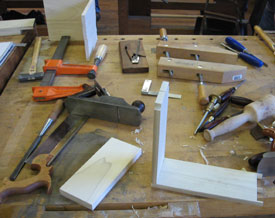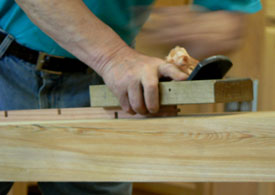A Nod to the Past or How to Do Your Part to Conserve Electricity
by Derreck Bryans
 Do you find yourself looking through woodworking magazines or surfing around websites with thoughts of carcass saws, mortise chisels, and bevel-up smoothing planes dancing through your head?
Do you find yourself looking through woodworking magazines or surfing around websites with thoughts of carcass saws, mortise chisels, and bevel-up smoothing planes dancing through your head?
Okay, I admit it. I have a problem. It seems as though this condition is very contagious, yet harmless to your health. Judging by the number of people who are going to wood shows, reading books, and buying hand tool technique videos, I am not the only one.
I think that a lot of us have grown up in an age where life is hurried and quality has been superseded by quantity and mass production. Think about it; when was the last time you went to a local department store and saw a piece of furniture that wasn't made out of particleboard (or the mysterious rubberwood, whatever that is). Look through furniture stores and count how many times pieces of furniture have a "cherrywood" finish. Why not build the piece out of cherry? Have a look at the drawers. If you are lucky enough, you may find the plywood-bottomed drawer may actually have machine cut dovetails. Look at the apron to leg attachment on that coffee table. A metal bracket is usually in the place of a strong and sturdy mortise and tenon. Sounding familiar?
I can remember taking my first wood shop class in grade nine. I remember entering into the shop after safety rules and theory in the classroom. A 12" inch General tablesaw beckoned to me. A 24" Oliver surface planer sat in the middle of the floor, daring anyone to feed it miles of rough lumber.
 What the shop teacher did was took all of us over to a massive wall cabinet. Inside were block and smoothing planes, rasps, squares hand saws of all description, chisels, and so on. These were to be the tools we used for the first half year of the class. He told us if we were good with our layout and learned the basics of making furniture and cabinets through the use of hand tools, the machines would be better respected by us once we were taught to use them. What a let down! Looking back after that first semester, I appreciated learning all of the hand tool techniques I was taught. A big help was the fact that Mr. Davis (the teacher) took pride in teaching us, and made sure that all of the tools we used were sharp and well tuned. These rip saws weren't the ones I remembered from the barn as a child (which wouldn't cut a thing, by the way). These tools could split a pencil line. The seed was planted.
What the shop teacher did was took all of us over to a massive wall cabinet. Inside were block and smoothing planes, rasps, squares hand saws of all description, chisels, and so on. These were to be the tools we used for the first half year of the class. He told us if we were good with our layout and learned the basics of making furniture and cabinets through the use of hand tools, the machines would be better respected by us once we were taught to use them. What a let down! Looking back after that first semester, I appreciated learning all of the hand tool techniques I was taught. A big help was the fact that Mr. Davis (the teacher) took pride in teaching us, and made sure that all of the tools we used were sharp and well tuned. These rip saws weren't the ones I remembered from the barn as a child (which wouldn't cut a thing, by the way). These tools could split a pencil line. The seed was planted.
Fast forward many years. Quite a few of the woodworking magazines I was reading were touting the benefits of a router jig that would joint boards. There were tablesaw tenon jigs to make life easier. And there were sanders that would make surfaces smooth and ready to finish. Yes, I succumbed to a lot of them. Not that there is anything wrong with that! But the router jointing technique was loud and not without its problems. The tablesaw tenon jig was fussy. And the sanders were noisy, dusty, and as far as I could see, took a surface and could gouge it, leave swirls, and scratches.
 I went to a woodworking show about six or seven years ago and met a person who changed the way I looked at woodworking. His name was Konrad Sauer of Sauer and Steiner Toolworks. With him he had brought a classic workbench, a piece of birdseye maple, and a beautiful infill smoothing plane which he had built. He let me hold the plane. He set the blade. Then he let me go nuts on the maple. I was amazed! There is nothing that compares to the sound of a sharp plane iron taking an onion skin-looking shaving from a board (birdseye maple, no less...and no tear-out!). It was a life-altering experience. With four passes of that plane, I saved five to ten minutes of sanding. And the surface- it felt incredibly smooth. It shimmered in the light. This plane felt amazing. It was an extension of my hand. I was hooked.
I went to a woodworking show about six or seven years ago and met a person who changed the way I looked at woodworking. His name was Konrad Sauer of Sauer and Steiner Toolworks. With him he had brought a classic workbench, a piece of birdseye maple, and a beautiful infill smoothing plane which he had built. He let me hold the plane. He set the blade. Then he let me go nuts on the maple. I was amazed! There is nothing that compares to the sound of a sharp plane iron taking an onion skin-looking shaving from a board (birdseye maple, no less...and no tear-out!). It was a life-altering experience. With four passes of that plane, I saved five to ten minutes of sanding. And the surface- it felt incredibly smooth. It shimmered in the light. This plane felt amazing. It was an extension of my hand. I was hooked.
Different magazines than I had been reading touted the skills of hand tool usage. Why spend ten minutes setting a dado blade in the tablesaw to cut a tenon when a tenon saw could cut one quicker and with less set up time? How to tune up flea market hand planes. How to make drawers with hand-cut dovetails. Drawbored mortise and tenons (no adhesives). I loved it. Fast forward again to the present.
We now seem to be enjoying a renaissance of sorts in the hand tool industry. Not for a long time has there been such a selection of quality muscle-powered tools. Taking a look at the web sites and catalogues of such companies as Lie Nielsen, Adria, Blue Spruce Toolworks, etc., is proving that hand work is alive and well.
And although the masters of old and the shop classes we all remember are passing through memory, we are blessed to be smack dab in the middle of the information age. Through printed, video, and computer-based media, we are able to learn things that may have only been taught to us through apprenticeships to old world masters. No matter if you want to learn how to dovetail a drawer, sharpen plane irons, or make a chair from a tree, the information can be easily found through various media outlets. It certainly helps that people such as David Charlesworth, Frank Klaus and Rob Cosman are sharing their knowledge of woodworking.
Let us not forget the quality aspects of the revolution. I can certainly say that I prefer the feeling of a well-tuned plane spewing forth wispy, translucent shavings than a poorly balanced, hand numbing palm sander.
Not to be forgotten either is the health matter. I myself over the years have noticed a steady decline in my hearing. I also tend to get a suspicious cough from certain wood dust. I certainly adhere to the dust and hearing protection crowd now, but if you can prevent some of the dust and noise in the first place, why not?
The final argument for hand tools is the Zen-like state that overcomes you when you use well-tuned and sharpened hand tools. A good hand saw will cut a thin kerf, and track like a hunting dog. A jointer plane will remove all of those tool marks from the edge of a board that you never noticed before. A sharp chisel will bring a tenon cheek down that last few thousands of an inch to make a perfect fit into a mortise.
Don't get me wrong. Power tools will always have a place in the modern shop. Speed and repeatability is on their side. They take the drudgery out of flattening a few hundred board feet of lumber, or ripping a kitchen's worth of face frame stock. But hand tools are the perfect complement to help with the final fit and smoothing of projects. Just ask yourself this question: Would that Philadelphia highboy be as appreciated and admired if it were made by a CNC machine? I think not.
Derreck Bryans hails from Cobourg, Ontario, Canada and has been woodworking since he "could pick up a smoothing plane." He works full time as a foreman on road building and installing sewers and watermains, and has a part time furniture business.